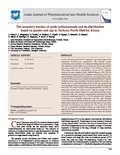The monetary burden of cystic echinococcosis and its distribution based on gender and age in Turkana North District, Kenya

View/
Date
2014Author
Joseph Odero
Magambo J
Zeyhle E
Kutima H
Ndahi L
Njoroge F
Mutwiri T
Mbaya H
Mbae C
Mulinge E
Kagendo D
Kern P
Romig T
Metadata
Show full item recordAbstract
Cystic Echinococcosis (CE) is caused by the larval stage of the tapeworm Echinococcus granulosus. The disease occurs worldwide, and is endemic in Turkana and Maasai areas, Kenya. The objective of the study was to assess the direct and indirect monetary burden of CE in Turkana North District of Kenya. This study involved a retrospective review of CE patients' medical records obtained from AMREF-Kenya(1991-2011), with patients originating from Turkana North district of Kenya. Data obtained were used to calculate CE- associated direct costs. A total of 586 surgical cases treated at Kakuma Mission Hospital, Turkana, Kenya were evaluated. The ratio of infection in male to female was 1:2, with individuals in the 31-40 age groups being most prevalent. The average direct cost of CE surgical treatment was US$ 703. Direct cost for 586 surgical patients, over the 20 year study period was US$ 453,154 with an average of US$ 22,658 per year. Annual indirect CE-associated monetary losses associated with lost economic opportunities amounted to US$ 4,414 for a herdsman and US$ 1,339 for a house wife. Turkana community is a nomadic pastoralist and the rural Turkana women lack formal education, their economic contribution to the family and community was evaluated on the basis of economic potential of a herdsman and a housewife. The results show that CE has a significant economic burden on individuals in this region. This requires immediate sustainable control measures at the definitive and intermediate hosts' level to reduce the burden of the infection.
